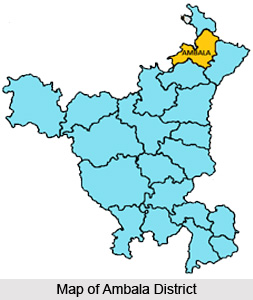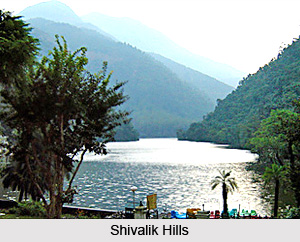 Ambala is one of the 21 districts of Haryana state. The headquarters of the district is Ambala town. Ambala District lies on the North-Eastern edge of Haryana between 27 degrees 39 minutes to 45 degrees North latitude and 74 degrees 33 minutes to 76 degrees 36 minutes East longitude. It is bounded by the district Yamuna Nagar in the South-East. To its South lies Kurukshetra District, while in its west are situated Patiala and Ropar districts of Punjab and the Union Territory of Chandigarh. The Shivalik Hills of Solan and Sirmaur districts of Himachal Pradesh bound Ambala district in the North and North-East. The average altitude of the district from the sea level is 900 feet approximately. As far the Administration is concerned, it has been divided into two sub-divisions which in turn have been further divided into three tehsils.
Ambala is one of the 21 districts of Haryana state. The headquarters of the district is Ambala town. Ambala District lies on the North-Eastern edge of Haryana between 27 degrees 39 minutes to 45 degrees North latitude and 74 degrees 33 minutes to 76 degrees 36 minutes East longitude. It is bounded by the district Yamuna Nagar in the South-East. To its South lies Kurukshetra District, while in its west are situated Patiala and Ropar districts of Punjab and the Union Territory of Chandigarh. The Shivalik Hills of Solan and Sirmaur districts of Himachal Pradesh bound Ambala district in the North and North-East. The average altitude of the district from the sea level is 900 feet approximately. As far the Administration is concerned, it has been divided into two sub-divisions which in turn have been further divided into three tehsils.
History of Ambala District
Ambala District has a rich history. Archaeological evidences suggest that the district has been in existence since the Palaeolithic times. The district of Ambala has also undergone multiple invasions from foreign invaders throughout the ages. It can be said about the district that it had been politically very active in the early ages and also had a strong religious fervour.
The District was explored during British period by A.C. Cunningham and C. Rodgers and later by B.B. Lal and many others. The earliest literary reference to the region comprising the Ambala District in the Taittiriya Aranayaka mentions Turghna as the bordering region towards the North of Kurukshetra. It is surmised that Ambala District was found by Amba Rajput during the 14th century AD. Another historical version says that the name is a corruption of Amba Wala or the mango-village judging from mango groves that existed in its immediate neighbourhood. Still another story is that the District has taken its name after goddess "Bhawani Amba" who`s Temple still exists in the Ambala city.
The earliest inhabitants of district were a primitive people using stone tools of lower Palaeolithic Age. These tools were found at various sites in the district like Tarlokpur etc. Unfortunately this district has not yielded any pre Harappan or mature Harappan site. The various evidence specially that of painted grey ware pottery support the fact that the Aryans also inhabited the region. The Ambala region was included in the Kingdom of Pandava and there successors. The Edicts of Ashoka chiefly Topara edicts and stupas at Singh and Chaneti associate the district with Maurayan Empire which further adds to the district with Mauryan Empire adding to the importance of place. The discovering of Sunga Terralottas suggests that they also held this area. At some places Kushan Bricks have also been found which justify the conclusion that this district was included in the Kushana Empire. This evidence is supported by Mehrauli Pillar Inscription and silver coins found at various places.
The region formed an integral part of nearly all the premier ruling dynasties of India. Some foreign accounts especially those of Chinese pilgrimage Huen Tsang who visited during Harsha regime show that this District was also under some influence of Buddhism. The district further witnessed the Imperial ambition of Yaso Verman of Kanauj and laladitya. After the invasion of Mohammed Ghaznavi, Charuhaus brought it under their control. The Topara Pillar stands Testimony of this fact. Finally the Muslims under took the district after the defeat of Prithviraj Chauhan in the second Battle of Terrain in 1192. Between 9th to12th centuries this district retained its importance as a centre of religious pilgrimage. The discovery of image of lords at several places suggests existence of beautiful temples which were probably destroyed during Muslim invasions.
Under the Muslims, the district formed a part of Kutab-Bin-Abak Empire. The region also witnessed the invasion of Timur. In 1450 Bahlol Lodhi the then governor of Punjab brought the area under his control till Babur`s invasion in 1526. Akbar`s reign was full of events in Din-E-Akbari .It is mentioned that mahals of Ambala were part of Sirhind of Delhi suba. After the Aurangzeb death the political position and various forces rose in opposition to the Empire. Banda Bahudar, a disciple of Guru Gobind Singh launched a fierce attack on Ambala area (1709-10) however he lost to Mughals at Sadhaura in 1710. After Banda, Khidmat, a Mughal official governed the Ambala Terrritory till 1739. After Nadir Shah`s invasion a dark period followed with the division of Ambala in to small principalities. Abdali had held the area from 1757 onwards. The restive Sikhs in 1763 came in possession of this territory after slaying Abdalis Governor. In short, during medieval age the district of Ambala was full of Political activities and turmoil`s.
Geography of Ambala District
Ambala District has an area of 1568.85 square kilometres. The district is mainly drained by non-perennial streams and the drainage system of the district comprises the Markanda River and its tributaries, the Dangri and its tributaries and the Ghagghar along with its tributaries.

The district of Ambala has a continental in climate. It is very hot in summers and markedly cold in winters. May and June can be really hot with the temperature soaring to over 48 degree Celsius, while in winter it can be as low as -1 degree Celsius. Ambala has a semi-arid as well as tropical climate. Being far away from the coasts and close to the Thar Desert in India, it does not get the full share of the monsoon current.
70 percent rainfall is received during the month of July to September and the remaining rainfall is received during December to February. Ambala is the maximum rain-hit area in Haryana with average rainfall being 47.16 inches per annum.
Administration of Ambala District
The Ambala district consists of three tehsils, namely Ambala, Barara and Naraingarh. To decentralize the authority in the administrative set-up, the district is divided into Sub-divisions, Ambala and Naraingarh. Ambala sub-division was created in 1968. The Naraingarh sub-divisions created in 1956.
Demography of Ambala District
Ambala has a population of 10.13 lacs of persons as per census of 2001. The number of males in Ambala are 5, 42,366 and the number of females are equal to 4, 71,294. The district of Ambala comprises 4.8 percent of the total population of Haryana. The number of literate population of the district are 6, 73,807. More number of males in the district are literate than the number of females. Respectively number of literate males and females are 3, 90,012 and 2, 83,795. The sex ratio in the district is 869:1000. The density of population in the district of Ambala is equal to 644 persons.
Education of Ambala District
There are a number of schools and colleges in the Ambala district. In fact there are several government colleges and post graduate educational institutes in Ambala district. Besides these there are polytechnic colleges, medical colleges, engineering and management institutes as well.



















